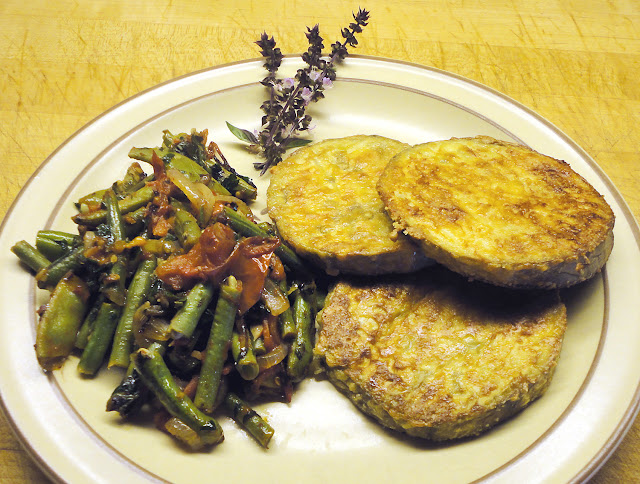 With the abundance of fresh garden veggies this time of year, here is a great recipe for zucchini, yellow summer squash, eggplant, and even green tomatoes. It's gluten-free, low fat, and low carb - and delicious. The original recipe was for eggplant, given to me by my sister Jean, but I didn't want those of you who don't eat eggplant to bypass this recipe if I titled it "eggplant parmesan". I tried it with yellow summer squash and it was equally yummy. Give it a try!
With the abundance of fresh garden veggies this time of year, here is a great recipe for zucchini, yellow summer squash, eggplant, and even green tomatoes. It's gluten-free, low fat, and low carb - and delicious. The original recipe was for eggplant, given to me by my sister Jean, but I didn't want those of you who don't eat eggplant to bypass this recipe if I titled it "eggplant parmesan". I tried it with yellow summer squash and it was equally yummy. Give it a try!1 eggplant OR zucchini or other firm fresh vegetable
4 egg whites *
4 T water
1/2 cup finely grated parmesan cheese
1 tsp garlic powder
pepper to taste
Use a shallow pan, lined with parchment paper and very lightly sprayed with cooking spray. Preheat oven to 400 degrees F.
If using eggplant, peel and cut into 1/4" rounds. If using summer squash, cut into rounds or, if it is very large and seedy in the center, cut 1/4" slices lengthwise around the center. If using green tomatoes, slice into rounds.
Beat egg whites and water in a flat bottomed dish, such as a pie plate. Mix parmesan cheese with garlic powder and pepper in a second pie plate. If your veggie pieces are small, you might put the cheese mixture into a plastic bag and shake the veggie slice to coat it. Dip your veggies, one slice at a time, into the egg then into the cheese mixture. Use more cheese if necessary. Place the slices in a single layer in the pan. When the pan is filled, lightly spray the tops with cooking spray. Bake for 10 minutes, then turn each piece over and bake for another 10 minutes, until golden brown. Serve with sauteed veggies as I did (all from the garden: carmelized onions, green beans, tomatoes, minced garlic, chopped basil, fennel seeds), and your meal is complete!
* Twice I have successfully substituted for the egg whites - one time I didn't have eggs, so I used the little can of powdered egg whites I keep on hand, and couldn't tell any difference in the results. When I took these photos, I used two whole eggs, since they were from my friend Susan's free range chickens and I didn't want to discard the yokes. You could also use premixed egg substitutes, but I feel the added ingredients (like coloring to make it yellow) are unnecessary.





